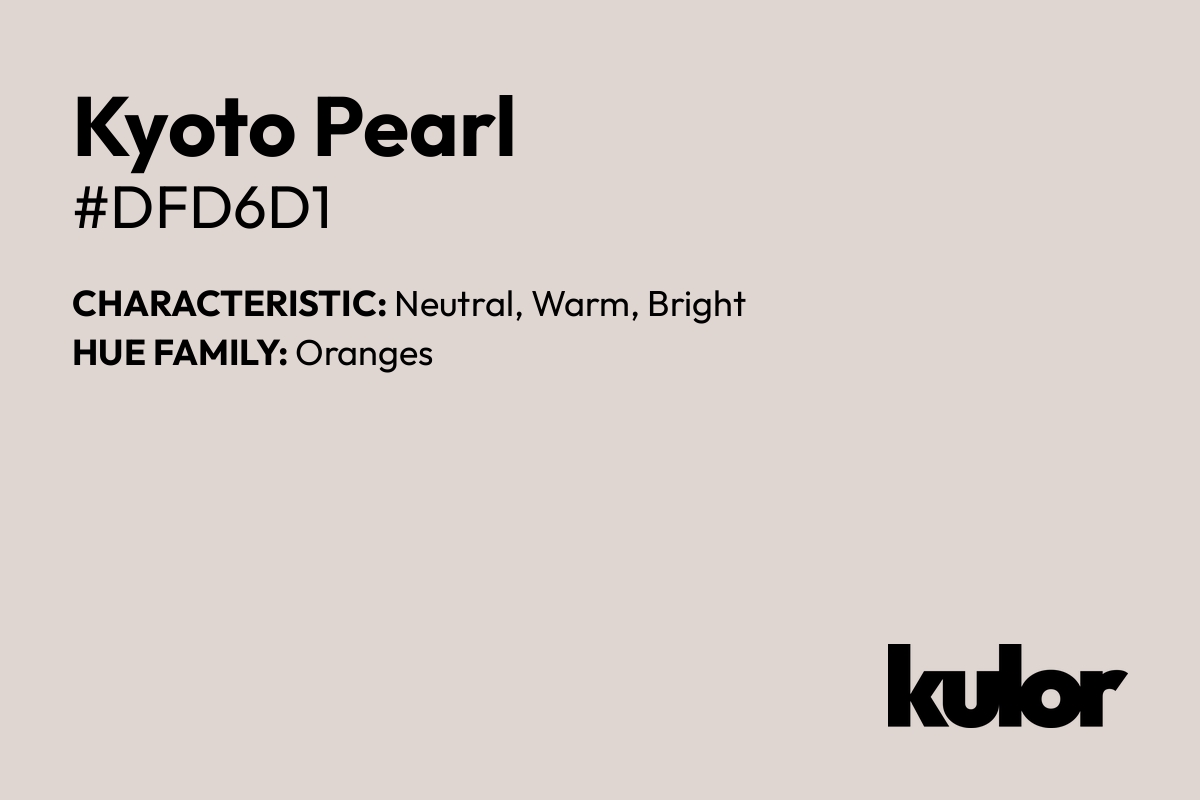Color Kyoto Pearl red-orange (#dfd6d1):
HEX, RGB color codes for HTML and CSS
The Comprehensive Guide to Kyoto Pearl red-orange (#dfd6d1):
Its Meaning and Harmonious Color Matches in Design.

Hue Family:
red-oranges
red-oranges Family:
light-muted
Saturation:
almost gray
Tones:
light-toned
Shade:
light
Temperature:
warm
Chromaticity:
near-grayscale
Chroma:
low chroma
Color Information about Kyoto Pearl / #dfd6d1
The HTML HEX code is #dfd6d1. The corresponding color name is "Kyoto Pearl". In RGB values (additive color space used for Digital Displays), this HEX code translates to Red (R): 223%, Green (G): 214%, Blue (B): 209%. In the CMYK color model (subtractive color model used in printing), it is represented by Cyan (C): 0%, Magenta (M): 4%, Yellow (Y):6%, Black (K): 13%. In the HSL color space, #dfd6d1 has a hue of 21°, saturation of 18%, and lightness of 85%. The HSV representation is 21° for hue, 6% for saturation, and 87% for value.
In the CIE-LAB color space, the color is denoted by L* (lightness) = 86, a* (green to red) = 2, and b* (blue to yellow) = 4. The XYZ representation is X: 66, Y: 68, Z: 70. In the YUV color space, it translates to Y (luminance) = 0.8475, U (chrominance) = -0.0137, and V (chrominance) = 0.0237.
The decimal value of the color is 14669521. The closest Web-safe HEX code is #CCCCCC. Variations of the colour are #FFFFFF for a 20% lighter version and #B6A196 for a 20% darker version.
For the color with hex value #dfd6d1, the correlated color temperature (CT) is estimated to be 5956 Kelvin (5956K).
The approximate wavelength of #dfd6d1 is around 658.00nm.
| VALUE | CSS | |
|---|---|---|
| HEX Code | dfd6d1 | #dfd6d1 |
| RGB Decimal Code | 223, 214, 209 | rgb(223, 214, 209) |
| CMYK | 0, 4, 6, 13 | / |
| HSL | 21°, 18%, 85% | hsl(21°, 18%, 85%) |
| HSV | 21°, 6%, 87% | / |
| CIE-LAB | 86, 2, 4 | / |
| XYZ | 66, 68, 70 | / |
| YUV | 0.8475, -0.0137, 0.0237 | / |
| Decimal value | 14669521 | / |
| Web-Safe HEX | CCCCCC | #CCCCCC |
| Color Temperature (CT) | 5956 Kelvin (5956K) | / |
| Estimate Wavelength | around 658.00nm | / |
The Depth and Diversity of Kyoto Pearl (Hex: #dfd6d1): Exploring its Impact in Design and Culture
Kyoto Pearl (#dfd6d1) exudes the serene elegance reminiscent of blooming cherry blossoms in a Japanese garden. Its delicate softness mirrors the gentle strokes of a calligraphy brush on rice paper. Like fresh snowfall, it evokes purity and tranquility. This color brings to mind the smoothness of polished marble statues, while its subtle warmth is reminiscent of the delicate blush on a pearls surface. Kyoto Pearl embodies the essence of grace, serenity, and timeless beauty, making it perfect for creating a soothing and sophisticated atmosphere in any design or space.
Download Stunning Kyoto Pearl Wallpapers and Backgrounds
Enhance your devices with our minimalistic yet captivating Kyoto Pearl Wallpapers, perfectly designed for 4K, 5K, iPhone, and Android screens. Experience a unique aesthetic that brings elegance to your digital life.
Experience Elegance with Kyoto Pearl 4K Wallpaper
Immerse yourself in the beauty of our Kyoto Pearl 4K Wallpaper, offering a resolution of 3840px by 2160px. Perfect for high-resolution displays, this wallpaper brings a touch of sophistication to your desktop.
Download Kyoto Pearl 4K WallpaperTints and Shades of #dfd6d1 HEX color (Kyoto Pearl)
In color theory, tints and shades are essential for understanding the depth and luminosity of colors. A tint is achieved by adding white to a pure hue, lightening its appearance. Conversely, a shade results from blending black with a color, giving it a deeper tone. In the context of #dfd6d1, this color stands at the center between its tints and shades. While the tints get progressively lighter moving towards white (#ffffff), the shades deepen towards black (#000000).
- #ffffff
- #F7F5F4
- #EFEBE8
- #E7E0DD
- #dfd6d1
- #A7A19D
- #706B69
- #383634
- #000000
Tones of Kyoto Pearl (#dfd6d1 HEX color)
A tone is produced by adding gray to any pure hue. In the case of #dfd6d1, #b9b4b1 is the less saturated color, while #dfd6d1 is the most saturated one.
- #b9b4b1
- #c3bcb9
- #ccc5c1
- #d6cdc9
- #dfd6d1
- #84746c
- #847268
- #857065
- #856e61
HTML Usage Examples
HTML using color code example
<p style="color: #dfd6d1;">This is a css example</p>HTML / CSS Color Name using W3C
W3C HTML / CSS Color Name doesn't exist for #dfd6d1.
CSS color code example
p { color: #dfd6d1; }Text with hexadecimal color #dfd6d1
This is a sample text with color #dfd6d1.
Background Color with #dfd6d1
This is a example with background color #dfd6d1.
Border Color with #dfd6d1
#dfd6d1 Color Preview on White (#ffffff) Background
This is a example of text with color #dfd6d1 on white background.
#dfd6d1 Color Preview on Black (#000000) Background
This is a example of text with color #dfd6d1 on black background.
CSS codes examples
.text {color:#dfd6d1;}.background {background-color:#dfd6d1;}.border {border:1px solid #dfd6d1;}